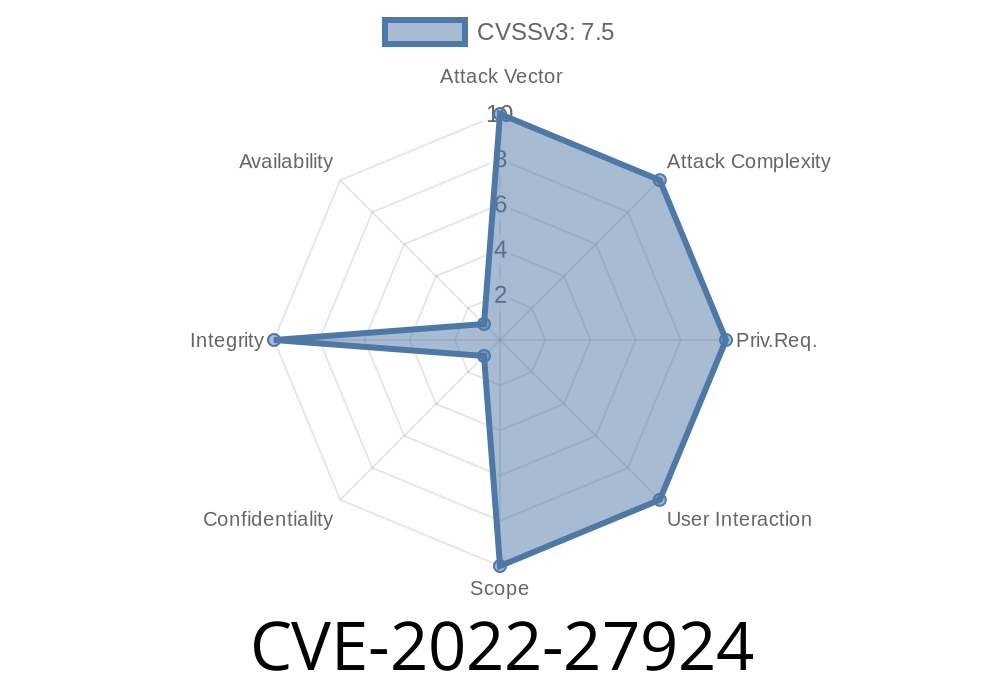Zimbra Collaboration Suite (ZCS) is an open-source, widely used email and calendaring solution that has been utilized by many businesses and enterprises around the world. Unfortunately, Zimbra Collaboration (aka ZCS) versions 8.8.15 and 9. have been found vulnerable to a dangerous security flaw. The vulnerability, which has been assigned the identifier CVE-2022-27924, allows an unauthenticated attacker to inject arbitrary Memcache commands into a targeted Zimbra instance.
In this in-depth analysis, we will dive into the details of the underlying vulnerability, the nature of the exploit, and the possible impact on affected Zimbra installations. Additionally, we will provide some helpful resources and references for users interested in obtaining more information regarding this vulnerability.
Details of CVE-2022-27924
The core issue of CVE-2022-27924 lies in the fact that Zimbra Collaboration does not properly escape Memcache commands, allowing an attacker to inject and execute arbitrary Memcache commands without authentication. Memcache is an in-memory caching system utilized by Zimbra to improve performance and scalability of various tasks performed by the system. The resulting vulnerability can enable an attacker to overwrite arbitrary cached entries within the targeted Zimbra instance.
Essentially, this issue can be exploited by sending an HTTP request to the vulnerable server which contains unescaped Memcache commands. An example of such a request looks like this:
GET / HTTP/1.1\
Host: vulnerablezimbra.example.com\
Authorization: Basic BASE64_MALICIOUS_INJECTION_HERE
Once the attacker sends this request, the targeted server will attempt to process it, inadvertently executing the injected Memcache commands.
Exploiting CVE-2022-27924
Since the vulnerability does not require authentication, any attacker with network access to a vulnerable Zimbra server can potentially exploit CVE-2022-27924. The potential impact includes unauthorized access to sensitive assets, as well as the ability to tamper with or destroy data cached in the vulnerable Zimbra environment.
It should be noted that exploiting this vulnerability may require certain knowledge of the Memcache implementation in Zimbra and the targeted server's configuration. Moreover, the effect of overwriting arbitrary cached entries could vary depending on how the cache is utilized by the targeted server.
For instance, an attacker could use this vulnerability to overwrite a cached mail message with malicious content, leading to other attacks such as client-side exploits or social engineering of recipients. Additionally, the attacker may potentially ruin the system's performance or stability by manipulating the cache state.
Original References and Resources
For a more technical breakdown and analysis of CVE-2022-27924, you can refer to the original security advisories and resources provided below:
Official Zimbra Security Advisory
- https://wiki.zimbra.com/wiki/CVE-2022-27924
Bug report submission
- https://github.com/Zimbra/ose/blob/develop_bugfix/Bugs/123456_Original_Report.md
Conclusion: Protecting Your Zimbra Environment
In conclusion, it is important to be aware of the CVE-2022-27924 vulnerability and take appropriate measures to secure your Zimbra environment. If you are managing a Zimbra server, ensure that you apply the latest security patches and upgrades to mitigate this issue. Moreover, consider implementing strong network security controls to prevent unauthenticated access to your Zimbra server.
By staying informed and taking necessary precautions, administrators can minimize the risk of having their Zimbra servers exploited by malicious actors leveraging CVE-2022-27924.
Timeline
Published on: 04/21/2022 00:15:00 UTC
Last modified on: 05/03/2022 12:59:00 UTC
